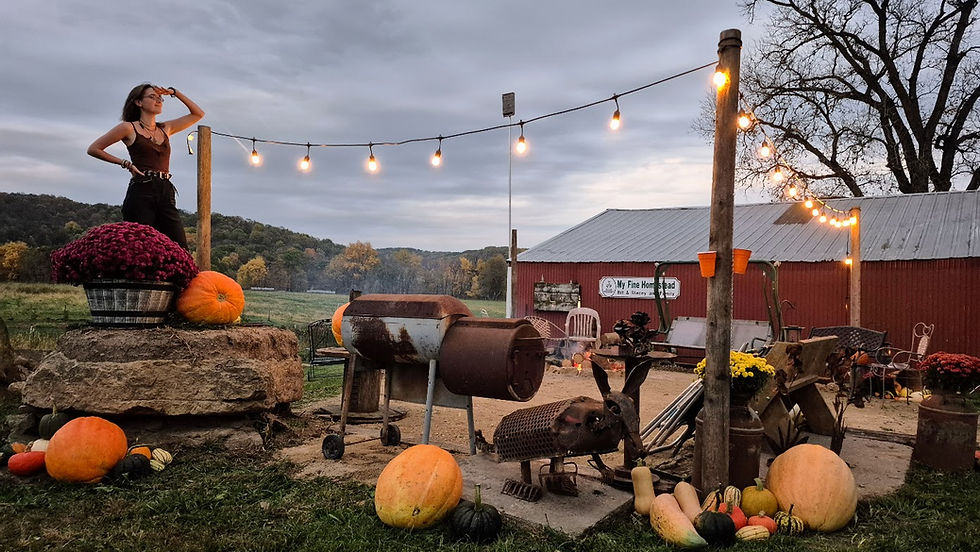Location, Wetlands and Grassy Paths Protect Us
- Stacey
- Sep 6, 2018
- 3 min read
"And the rains came down" ... and kept coming down.

Everything is wet! We've experienced flash flood warnings the last two nights and have received almost 3 inches of rain since midnight on top of several inches from the night before. Schools in our area haven't had their first day yet because of water-covered roads. The annual Viola Horse and Colt show is cancelled, and the local Richland County Fair is cancelling the carnival and all grand stand events this weekend due to flooding -- a first as far as Bill and I know!
Here on the farm, the ground is saturated and
paths out to the vegetable fields have standing water. Driving out without getting stuck is dicey. Rubber boots are the favored footwear, and the pitter patter of rain outside the window has become more menacing than relaxing. But the good news is - our buildings, crops, and animals remain relatively unscathed.
We have missed some of the heaviest downpours, but we believe we've avoided more devastating effects of all the rain for several reasons.
We logically benefit from the higher location of our farm buildings and the levelness of our crop ground. While the creek is over it's banks, we can observe it from behind the barn without being worried it will reach us.
The wetlands that surround Byrds Creek as it moves through the middle of our farm are home to many diverse species of plants and animals. We've appreciated that characteristic for many years, but this recent extraordinary weather has us realizing just how valuable the marsh is to our farm. The wetlands are absorbing and holding much of the excess water from the rain and the overflowing creek. They also filter all that water as it slowly moves underground into the water table. Some folks even call wetlands "the kidneys of the earth."
And the farming practices of planting in permanent beds and not tilling the foot paths between the individual beds is also helping our crops withstand the onslaught of rain.
Let me back up and explain how our two acres of vegetable fields are set up. They are located in an old hayfield to the north of our house, and the area is divided into eleven sections of roughly 100 feet by 100 feet. There are 22 or 23 permanent beds within each section which are 100 feet long by 30 inches wide. The beds within each section are separated from each other by 18-inch walking paths. These paths have grass growing in them.

So instead of using a bigger tractor to till a whole section, form beds, and then plant, Bill uses our walk-behind tractor to "work" only the 20-odd beds where the vegetables will grow. And he only applies compost, fertilizer, and minerals to those areas. Because the beds are so narrow we can avoid walking in them which limits soil compaction while encouraging healthy underground microbial activity and absorption of water, nutrients, and minerals. The paths are virtually ignored other than when Aidan mows them because the grass is too tall.
Grassy walking paths between tiny, newly planted lettuce heads. If we tilled the whole section, the paths between the beds would also be very muddy!
Concentrating our time on the desired areas in which we plant means we conserve not only energy, but also resources such as labor, compost, fertilizer, minerals, fuel, and money.
As I mentioned, the paths are left alone except for mowing. While that takes some time and fuel, it is worth the trade-off, not only for the reasons I've already mentioned, but also for other reasons -- some of which we are appreciating now.
We've found that all that vegetation in the paths protects the crops and soil in different ways. Keeping the unused ground covered keeps soil temperatures several degrees cooler than if it was directly exposed to the sun during hot summer days. And right now it's preventing soil erosion and nutrient run-off by slowing down running water so more can be absorbed -- much like the practice of terracing.
And practically, the paths means that when it's wet outside from rain or dew we can walk in the wet greenery instead of slogging through mud. When we leave the fields the dirt stays in the beds where we want it instead of sticking to our boots and being tracked into the house.
The forecast for the next few days includes more rain, but then it should dry up a little - - we may even see the sun. We are looking forward to that, but for now we are thankful for our location, our marsh, and for our grassy paths.












Comments